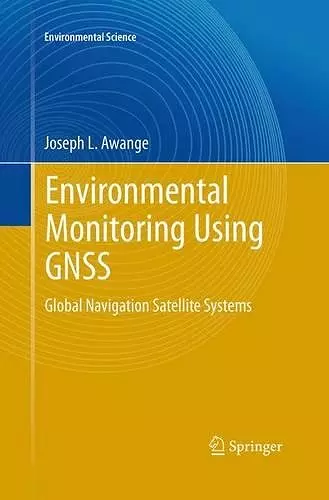Environmental Monitoring using GNSS
Global Navigation Satellite Systems
Format:Paperback
Publisher:Springer-Verlag Berlin and Heidelberg GmbH & Co. KG
Published:23rd Aug '16
Currently unavailable, and unfortunately no date known when it will be back

Global Navigation Satellite Systems (GNSS) are revolutionizing the world in a way their original developers never envisaged. From being military “war” tools, GNSS satellites are rapidly becoming “peace” tools that play a potentially critical role in enabling changing environmental phenomenon that do not permit direct measurements to be remotely observed via their all-weather, highly accurate and continuously updatable positional time series. This is evident, for example, in their use in emerging environmental monitoring methods that are considered in this book. These include: GPS-based radio telemetry, which is enhancing ecological and conservation monitoring by more accurately mapping animal movements, their behaviours, and their impact on the environment; GNSS-meteorology, which is contributing to weather and climate change studies; GNSS-remote sensing, which, for example, allows the rapid monitoring of changes in fresh water resources and cryosphere; Geosensor network techniques, which are earning a crucial role in disaster response management; Epidemiology, for improved efficiency in tracking and studying the spread of infectious diseases and climate change effects on vector-borne diseases; and Economics, to provide data for the econometric modelling of casual impact of policies. In Environmental Impact Assessments (EIA), Strategic Environmental Assessments (SEA), and Sustainability Assessments (SA), GNSS, together with other spaced-based remote sensing techniques, are emerging, not only as modern tools that connect the developers to the community, but also provide information that support Multi-Criteria Analysis (MCA) methods, which inform decision making and policy formulations.
By bringing the two fields of geodesy (the parent of GNSS technology) and environmental studies (potential users of this technology), this bookpresents the concepts of GNSS in a simplified way that can, on the one hand, be understood and utilised by environmentalists, while on the other, outlines its potential applications to environmental monitoring and management for those engaged more with its technology, which hopefully will further energise the already innovative research that is being carried out. Lastly, this book is most relevant to all the professionals whose work is related to the environment such as hydrologists, meteorologists, epidemiologists, economist, and engineers, to name just a few.A comprehensive yet candid and compelling presentation of Global Navigation Satellite Systems and its application to environmental monitoring and a host of other socio-economic activities. This is an essential and new ground breaking reading for all professional practitioners...
From the reviews:
“Author Joseph L. Awange opens by providing readers with a summary of what GNSS involves in terms environmental monitoring. … chapters of the book include a summary of GNSS technology, how it operates and comparisons between different systems. This information provides enough detail to allow both professional and non-professional GNSS readers to maintain interest … . Readers can learn in this book about designing monitoring surveys and mission planning for their field operations.” (Jeff Thurston, 3D Visualization World Magazine, 3dvisworld.com, July, 2ISBN: 9783662518250
Dimensions: unknown
Weight: unknown
382 pages
Softcover reprint of the original 1st ed. 2012